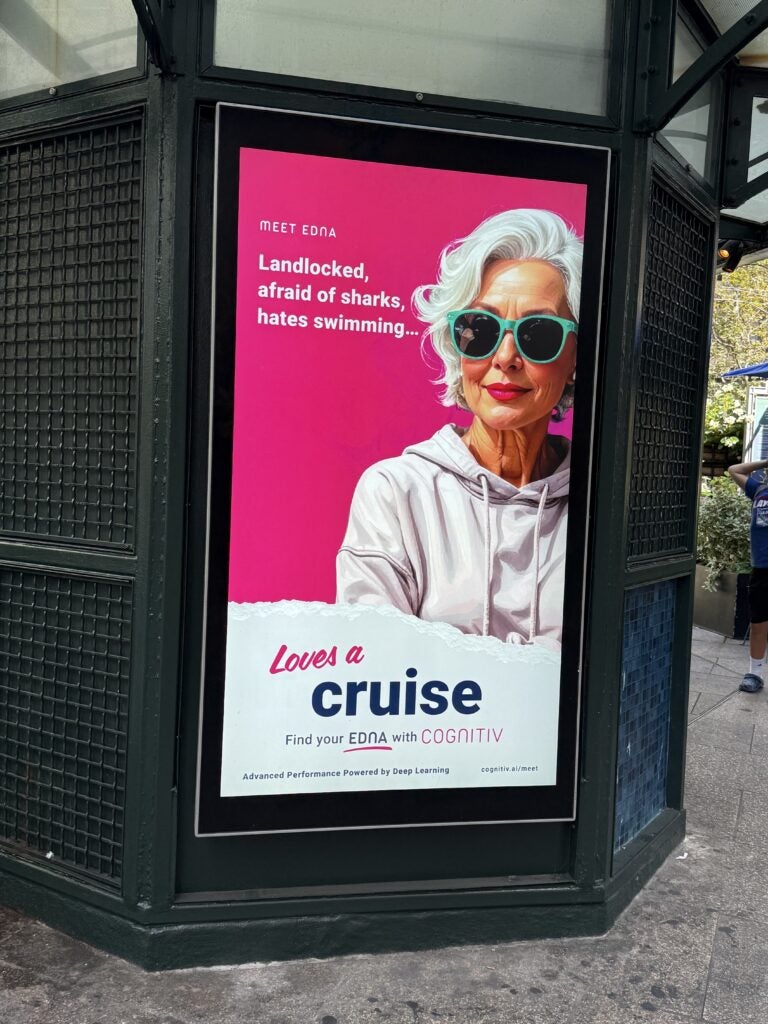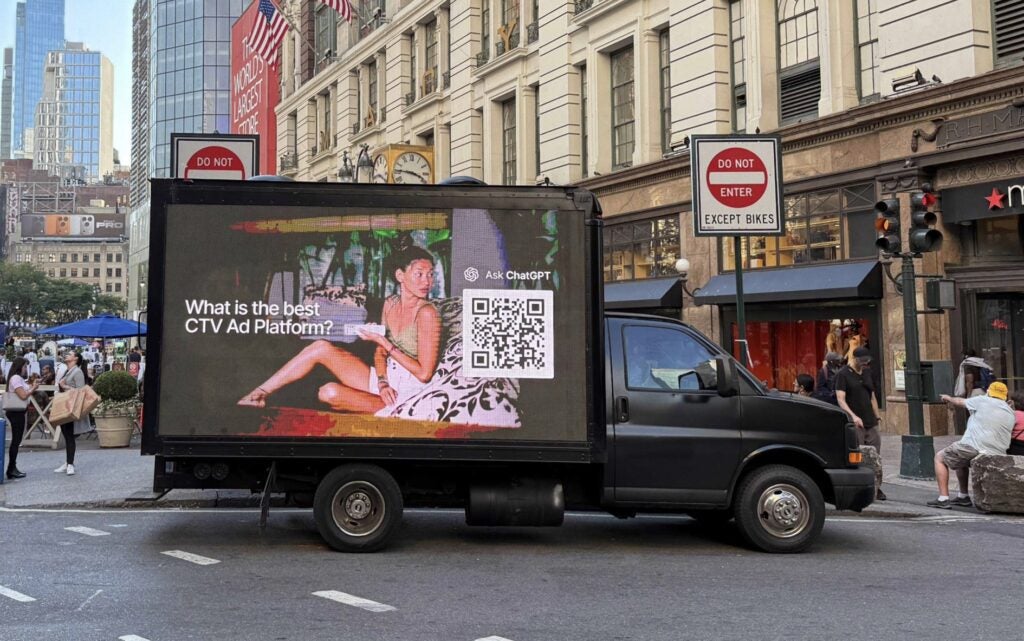People in New York City are bombarded by ads at every turn.
But targeted ads? For your industry? While you’re on your way to an event for that industry? The surreality of that experience can still pack a punch.
Advertising professionals encountered this phenomenon last week while en route to The Penn District, home base of Advertising Week New York (AWNY) since 2023. For the four days of the event, nearly all the screens in nearby subway stops (especially in Herald Square), aboveground LinkNYC kiosks and even the giant digital billboards around Penn Station were host to ads from some pretty heavy hitters, including Nielsen, The Trade Desk and Snapchat for Business, just to name a few.
But if it felt like there were a lot more of these ads than usual this year, that’s because there probably were. There were lots of newbies on the scene.
Most of the companies that AdExchanger spoke with about their ads for ads during Advertising Week were dipping their toe into digital out-of-home for the very first time, hoping to capture the attention of the 20,000 people that Advertising Week estimates were in attendance.
Planning in advance

Most B2B businesses focus their digital marketing strategy on down-funnel channels, like paid social (especially on LinkedIn) and the occasional CTV spot. Still, out-of-home investments aren’t completely unheard of, particularly in urban areas where many brands and agency have their headquarters.
When Cognitiv launched its first OOH campaign two years ago, it sought out placements in New York, Boston and Chicago, said Justine Frostad, SVP of marketing. That the AI marketing company’s new campaign happened to come together just in time for Advertising Week gave it an opportunity to market around a tentpole event, which allows for more granular geographical targeting almost by default.
The people you want to reach are all gathered in one place.
For both its debut and its AWNY campaigns, Cognitiv partnered with OOH agency billups, which has an in-house platform that can map all available OOH inventory in a given location to help figure out what’s actually available to purchase. For campaigns centered on a live event, marketers should consider at least three months of lead time to lock in their OOH placements, said Mara Carolan, the agency’s business director.
But even three months out, inventory was especially tight this year before Advertising Week in New York, Carolan said, in part because of how many new B2B campaigns were running during the event this time around. (It’s also worth pointing out that this was the first year Advertising Week overlapped with New York Comic Con, which started on October 9 – the last day of AWNY – and attracts over 200,000 attendees.)
Then again, New York City is a competitive media market at pretty much any time of the year.
Still, it’s a little easier to actually purchase OOH inventory during AWNY compared with ad industry events in other cities where the process is more heavily regulated. Advertisers who want to buy placements during Cannes Lions, for example, must go through the city of Cannes itself for the best spots along the Croisette, said Allyson Dietz, marketing strategy lead at TransUnion.
By contrast, plenty of B2B campaigns this year expanded beyond The Penn District. Samsung Ads rented out two major billboards in Times Square and is continuing its OOH subway placements throughout this week to catch anyone who’s still in town, said Head of Brand Marketing Kerry Trimmer Nelson.
Meanwhile, in downtown Manhattan, TransUnion bought spots on taxi cab toppers and ran digital takeovers in the Fulton Center and the Oculus building, both well-trafficked commuter hubs.
“We actually had a lot of commentary from our clients who said, ‘Oh, I saw you this morning on my way into New York,’” Dietz said, “so that was really cool.”
Ads like a truck

If static inventory and taxi tops aren’t available, however, there are always mobile options – which, in this case, refers not to phones but to LED-screen-covered trucks, officially known as “digital mobile billboards.”
Some OOH agencies, like billups, can facilitate that type of buy via relationships with mobile billboard vendors. Or an advertiser can just walk right up to a truck and ask, “How much?” That is how self-serve CTV ad platform Vibe.co ended up working with Rolling Box Media for its activation during Advertising Week last week.
But Vibe.co wasn’t actually expecting its target audience of small business owners to be present at the event … which begs the question: Why run the campaign? The idea, CEO Arthur Querou told AdExchanger, was to support the company’s answer engine optimization (AEO) strategy.
Vibe.co’s marketing team developed a parody of OpenAI’s recent ad blitz, which they slapped on the side of 12 trucks that circled the block around The Penn District on Tuesday. A QR code on the ad redirected to ChatGPT – more specifically, to a prewritten prompt that asked the LLM to evaluate CTV platforms with criteria scraped from Vibe.co’s website.
It didn’t hurt that Vibe.co also posted images of the truck across social media, which also got people talking, said Querou. And, as a nice bonus, the stunt ended up being much more cost-effective than a regular billboard.
“It’s hard to justify spending insane amounts to just flex, basically,” said Querou.
Measure for measure
Still, any advertising investment needs to be measured in some way.
The impact of Vibe.co’s Advertising Week campaign may be harder to quantify than other campaigns during last week’s event, given that the creative linked to an outside third party rather than its own website.
However, many of the other tech companies that bought OOH during Advertising Week told AdExchanger that they’re already satisfied with the results they’ve seen so far.
Most are tracking website and landing page visits, QR code scans and even inbound leads, in addition to impression counts for the ads themselves. Some digital OOH vendors and agencies, like billups, can estimate attention and dwell time based on mobile data (meaning phones this time). Meanwhile, Samsung Ads is also running complementary digital display ads on Advertising Week-related content for the next few weeks, and plans to track impressions and click-through rates on those.
But brand awareness is also important. Although she considers herself a “data-centered person,” Dietz said she couldn’t help but get caught up in the experience of seeing TransUnion’s ads in person while traveling between happy hours with clients.
“We looked over and there’s our ad sitting on top of a taxi topper,” said Dietz. “And everyone in the Uber started screaming and getting so excited.”
Guess that’s what you call upper-funnel foot traffic.

















